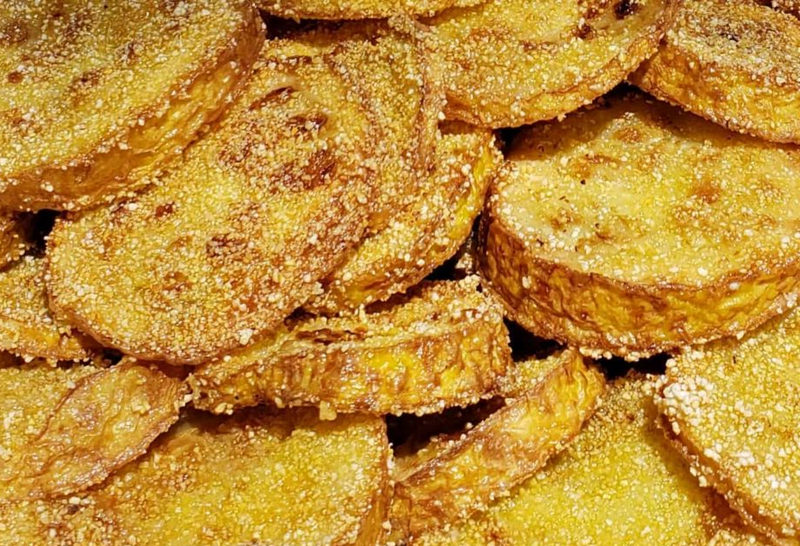If you want to enjoy delicious fried squash every time even in seasons when it is not available, you should know how you should freeze squash. The best method to preserve your squash is by freezing it whenever you buy too much or have it in abundance as a result of cultivating it in your garden.
You can store squash inside your freezer to become frozen until you want to use it to cook later. However, our main question is how you should freeze squash that you want to later fry. You will freeze squash to fry it similarly to how squash should be normally frozen except that there is a need to flour and season your vegetable before you place it inside the freezer. You should keep reading if you want to find out more about freezing your squash to later fry it.
Step By Step – How To Freeze Your Squash For Frying
Check below for the steps needed to be followed if you want to freeze your squash properly for frying:
Things You Need
The best thing is to have every of the needed tools and items for freezing the squash ready even before you start because through that, you will save yourself from wasting time when you are undergoing the process: The things you need include:
- Flour and seasoning
- Wax paper or freezer paper
- An air-tight lid container, plastic freezer bag, aluminum wrap, or plastic wrap
- Fresh squash
How To Prepare your Squash For Freezing
It is a very important step to prepare squash for the process of freezing because the taste will not be great when you fry it if you have not prepared it rightly.
- First, wash your squash the same way you would when you want to use it to cook.
- Use a paper towel to pat it dry.
- Depending on the thickness you want, cut your squash into ¼ or 1/8 slices.
- Once you have cut it, cut several freezer paper sheets that are a bit bigger than each of the slices but the sheets should have smaller sizes than that of the containers you want to use to freeze them.
Freezing Your Squash
The next step is to get the squash ready for freezing. You have to include an additional step as you freeze the squash you want to fry later and it will more effort than when you are just trying to freeze plain squash.
- Use pepper and salt to season the squash slices and you can also include other seasonings you want.
- Once the slices are seasoned, flour them.
- Shake excess flour off the slices.
- Use a freezer paper to line the base of the freezable container you want to use.
- Lay a floured squash slice on your freezer paper.
- Continue to layer your freezer paper on it and a slice of squash until you are done with the slices or until you have no more space left within the container. From here, you could use another container and line it with freezer paper before you proceed with the remainder.
- Seal the container’s lid tightly and place it inside the freezer for storage.
Other Storage Options
Instead of using plastic containers to freeze your squash, you can also use some other options. Each slice of squash could be layered alternating with a freezer paper to form a stack. You could get a reusable food wrap. Plastic wrap can then be used to wrap your stack and then wrapped again in pieces of aluminum foil before you place it into your freezer.
An alternative method you can use is to use plastic wrap to wrap your stack and then get a freezer bag (plastic) to put them inside. The squash could also be flash-frozen in case you don’t have any wax or freezer paper. All you need to do to achieve this is to slice the squash, season, and also flour it. You will put the slices on a prepared baking tray rather than layer them in stacks.
Put the baking tray inside your freezer for about 45 minutes until the slices are frozen. You can then place them inside a freezer bag or plastic container once they are frozen. The process of flash freezing will prevent separate squash slices from being stuck together when they become frozen.
You are allowed to remove the number of slices you wish to use from your freezer without needing to use or thaw the entire batch thanks to both flash freezing and using freezer paper to layer the slices. Don’t forget to put a label on the container and the freezing date so that you can easily identify it and you can know the limit of time you have to use the squash.
Frying Your Frozen Squash
When you want to fry your frozen squash, only little effort is needed, all you should do is just to fry because you have already added season and flour to the slices. You should not first defrost the squash before you fry it because thawing willing allow it to get soft and it might turn soggy thanks to the coating of flour.
Remove the number of slices you want to take from your container and put them inside an already preheated skillet. The slices will thaw for the first few seconds and they will be beautifully cooked crisp and through during the rest of the time. The batter will be exposed to moisture when you thaw the slices before you fry them and it will turn them gooey disallowing the slices from being crispy when you fry them.
Blanching Your Squash Before Freezing
You could decide to blanch your squash or any other vegetable before freezing. Bacteria and enzymes can be found in vegetables and they can breakdown or destroy the flavor, texture, color, and nutrients of the vegetables over time as they stay frozen inside the freezer. You can stop this by blanching your squash which will destroy the enzymes just before you freeze.
This is not necessary if you only want to freeze your squash for some time, but in case you don’t know when you would use your squash, blanching might be ideal for you before you freeze your squash. Boil a pan of water on your stove and put your sliced squash inside the boiling water allowing it to cook for about 3 minutes at that high temperature.
This same water can be used about 5 times if you want to freeze several slices of squash. However, there might be a need for you to add more hot water if you want the level of the water to be retained. Remove these slices safely from the water and put them to cool inside ice-cold water for about 5 minutes. When you cool the squash quickly, you will stop it from further getting cooked and you may have to add extra ice to ensure the water is kept cool.
For a minimum of 2 minutes, thoroughly drain your squash before using a paper towel to pat the slices. You may then get the squash seasoned and floured and put them inside the freezable containers for freezing. The time you will spend to fry your squash will also be shortened if you blanch the slices before freezing. The squash will defrost when you place it inside a hot skillet where it will also fry for you to enjoy.

Freezing Your Squash For Cooking
In case you have leftover slices after flouring and freezing enough slices, the remaining could be frozen so that you can use it for any other meal. Follow all our freezing steps above but you can cut your squash anyhow you want whether cubed or sliced. There is also no need for you to season or flour your squash.
The squash will become a bit soggy and mushy when you thaw it and it cannot be consumed raw, you will need to cook it with some other ingredients adding it to your casseroles or soups.
Related Questions
How do you stop fried squash from turning mushy?
If you want to prevent your squash from becoming mushy, fry it directly from frozen. Moisture will not be exposed to the squash when you use it directly from your freezer and you can have nicely crispy squash when fried. You should also be careful so that you will not overcook your squash because it could turn mushy.
Does squash need to be peeled before frying?
The skin of summer squash is delicately soft, you don’t need to peel it before frying. You could wash the squash’s skin if you want to freeze it for frying and then slice it into very thin slices, just before you season and flour it.
What happens if you freeze vegetables without blanching them first?
Blanching will usually help your vegetables to retain their nutrients and keep the colors by preventing the enzymes that could spoil them. If you don’t blanch your vegetables before freezing them, the color could fade or become dull and the tastes and textures will also be unusual.
If you want to use the vegetables any time soon, you don’t have to blanch them before freezing. However, if you want them to stay long inside the freezer, blanching is your best bet.


